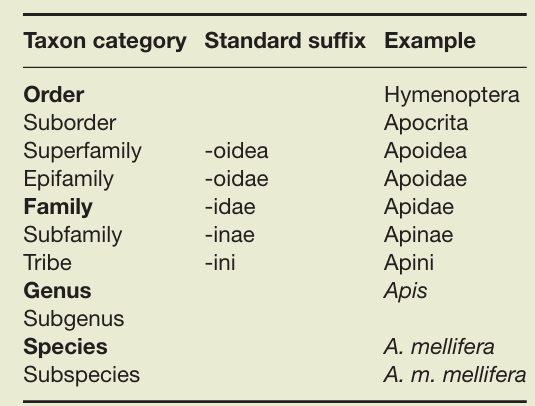
NAMING AND CLASSIFICATION OF INSECTS
 المؤلف:
P.J. Gullan and P.S. Cranston
المؤلف:
P.J. Gullan and P.S. Cranston
 المصدر:
THE INSECTS AN OUTLINE OF ENTOMOLOGY
المصدر:
THE INSECTS AN OUTLINE OF ENTOMOLOGY
 الجزء والصفحة:
5th E, P10-11
الجزء والصفحة:
5th E, P10-11
 2025-01-23
2025-01-23
 1217
1217
The formal naming of insects follows the rules of nomenclature developed for all animals (plants have a slightly different system). Formal scientific names are required for unambiguous communication between all scientists, no matter what their native language. Vernacular (common) names do not fulfil this need: the same insects may even have different vernacular names amongst people who speak the same language. For instance, the British refer to “ladybirds”, whereas the same coccinellid beetles are “ladybugs” to many people in the United States. Many insects have no vernacular name, or a common name is given to multiple species as if only one species is involved. These difficulties are addressed by the Linnaean system, which provides every described species with two given names (the binomen). The first is the generic (genus) name, used for a broader grouping than the second name, which is the specific (species) name. These Latinized names always are used together and are italicized, as in this book .The combination of genus and species names provides each organism with a unique name. Thus, the name Aedes aegypti is recognized by any medical entomologist, anywhere, whatever the local name (and there are many) for this disease-transmitting mosquito. Ideally, all taxa should have such a Latinized binomen, but in practice some alternatives may be used prior to naming formally . In scientific publications, the species name often is followed by the name of the original describer of the species and perhaps the year in which the name first was published legally. In this book, we do not follow this practice but, in discussion of particular insects, we give the order and family names to which the species belongs. In publications, after the first citation of the combination of genus and species names in the text ,itis common practice in subsequent citations to abbreviate the genus to the initial letter only(e.g. A. aegypti). How ever, where this might be ambiguous, such as for the two mosquito genera Aedes and Anopheles, the initial two letters Ae. and An. are used.
Various taxonomically defined groups, also called taxa (singular: taxon), are recognized amongst the insects. As for all other organisms, the basic biological taxon, lying above the individual and population, is the species, which is both the fundamental nomen clatural unit in taxonomy and, arguably, a unit of evolution. Multi-species studies allow recognition of genera, which are discrete higher groups. In a similar manner, genera can be grouped into tribes, tribes into subfamilies, and subfamilies into families. The families of insects are placed in relatively large but easily recognized groups called orders. This hierarchy of ranks (or categories) thus extends from the species level through a series of “higher” levels of greater and greater inclusivity until all true insects are included in one class, the Insecta. There are standard suffixes for certain ranks in the taxonomic hierarchy, so that the rank of most group names can be recognized by inspection of the ending (Table 1).

Table1. Taxonomic categories (obligatory categories are shown in bold).
Depending on the classification system used,some25 to 30 orders of Insecta may be recognized. Differences arise principally because there are no fixed rules for deciding the taxonomic ranks referred to above– only general agreement that groups should be mono phyletic, comprising all the descendants of a common ancestor . Over time, a relatively stable classification system has developed, but differences of opinion remain as to the boundaries around and among groups, with “splitters” recognizing a greater number of groups and “lumpers” favoring broader categories. For example, some North American taxonomists group (“lump”) the alderflies, dobsonflies, snakeflies and lacewings into one order, the Neuroptera, whereas others, including ourselves, “split” the group and recognize three separate (but clearly closely related) orders, Megaloptera, Raphidioptera, and a more narrowly defined Neuroptera. The order Hemiptera has sometimes been divided into two orders, Homoptera and Heteroptera, but the homopteran grouping is invalid (non-monophyletic) . New data and methods of analysis are further causes of instability in the recognition of insect orders. two groups (termites and parasitic lice) previously treated as orders, belong within each of two other orders and thus the ordinal count is reduced by two.
 الاكثر قراءة في الحشرات
الاكثر قراءة في الحشرات
 اخر الاخبار
اخر الاخبار
اخبار العتبة العباسية المقدسة


